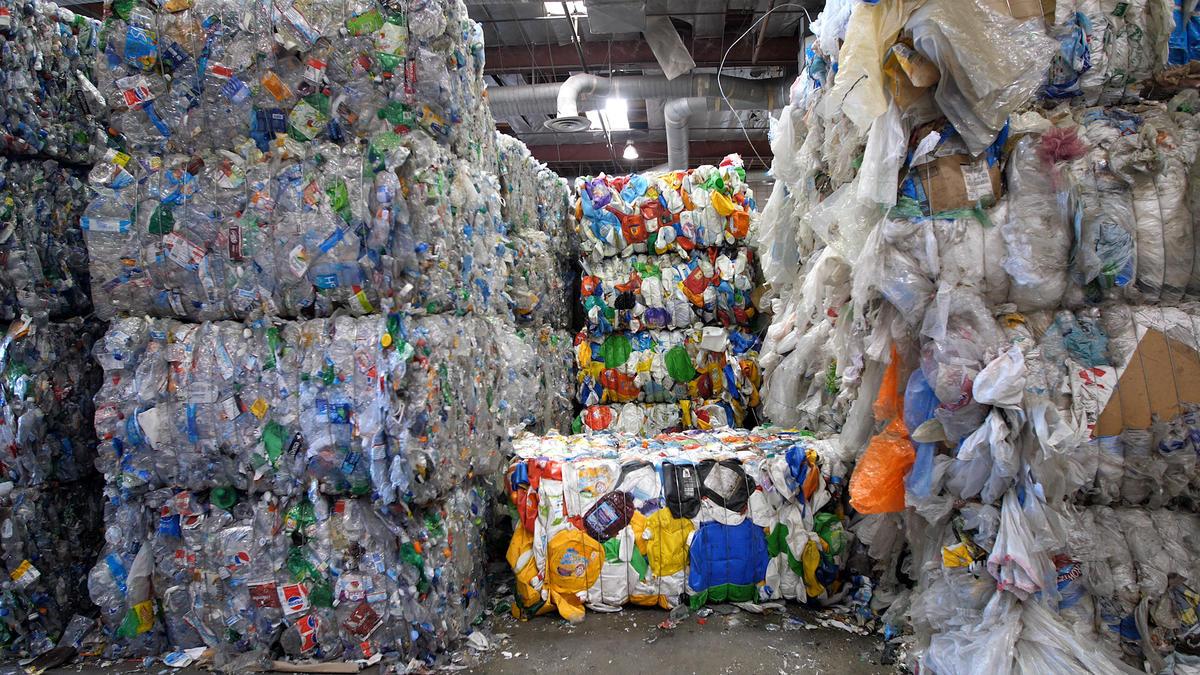Drowning in plastic, but not sure how to set yourself free? Plastic purgers say you can drastically reduce, if not eliminate, your plastic consumption by changing a few daily habits.
See: Steven Kurutz, New York Times Feb. 16, 2019, Online, accessed 8/16/2021 New York Times “9 Ways to Cut Down on Plastic”

https://www.nbclosangeles.com/news/national-international/how-china-policy-called-national-sword-is-causing-a-recycling-mess-in-the-united-states/2131151/
Since China began rejecting our plastic waste, the problem of plastic trash has become a nightmare. Recycling centers have had to close in some areas, Hawaii, being an island state, can no longer recycle most things plastic so it is winding up in landfills and, as hard as the state tries, the plastic growth in the Pacific Ocean has grown. This past July there was a ban placed on all single-use plastic for takeout food packaging, statewide. Food grade compostable material is now in use but, there is yet to be a composting center equivalent to that of Kansas City’s own Missouri Organic Recycling (see: https://www.missouriorganic.com). Our lifestyle is in need of a drastic overhaul.
Like many changes that we make to our daily lives, sustainable living has a learning curve. WE do not need to be “sustainably perfect” people but we do need more people to participate. A study in January 2021 found that 50% of the plastic waste comes from single-use plastic (see: Seed Scientific, Online, accessed 8-21-2021: 51+ Disturbing Plastic Waste Statistics [2021 Update] https://seedscientific.com/plastic-waste-statistics/)
If only a fraction of the human population is perfectly recycling, that leaves the majority doing nothing. Without 100% participation, even if imperfect, we will never rid ourselves of plastic debris.
We simply need to strive towards conscientious use of safe, environmentally friendly products to be able to practice sustainable living. In doing so, we go through a learning process and we get better and better at living sustainably. We start by learning new methods, we start thinking out of the box to garner new ways to live, in ways that do not detract from the precious time that we have in our busy daily schedules. In doing so, we help the earth heal from the current mess that we have made of our planet and thereby, begin to live with awareness and purpose in our daily lives.
Let’s look at how a change in behavior can be the first step to make a big impact on reducing trash that ends up spewn across the globe. Let’s start with reducing single – use plastics to the eventuality of total elimination. So, where does one start in this process?
Get the whole family involved as a project and learning experience. Start by taking an inventory of all the plastic in your home, room by room. Next: 1) identify single-use plastics, like logoed grocery bags and single-use water bottles; 2) multi-use plastics, like those you re-use to store food in the fridge; 3)long-term or life-time products such as plastic cased appliances, plumbing etc. Although there is a lot of unseen plastics in our homes, keep it to these three categories when taking inventory for the sake of simplicity, especially if children are participating. You may want to use the following link to find a Plastic Pollution Calculator: Plastic Pollution Calculator. (Earth Day Network Online, accessed 8/16/2021)
A reminder of the different categories of plastic waste:
- Single-use; anything from plastic grocery bags, plastic straws, stretch wraps, throw-away water bottles and sandwich bags, to the laundry detergent bottle that is replaced with another bottle of laundry detergent.
- Multiple-use: Plastic food storage boxes, those items that are used over and over until the plastic wears out (breaking or cracking etc.), plastic strainers, plastic cooking utensils, plastic bowls, plates etc. (Also be aware that the older plastics in this category may be leaching toxins into your foods. This was explained in a previous article in this series).
- Long-term single-use plastic: This category includes: Televisions, stereo equipment, computers, phones, tablets, toys, games, plumbing fixtures, summer pools, blow-up mattresses, etc., even some furnishings such as lamps, tables, chairs etc.
Once you have an idea of just how much plastic has infiltrated your personal space, start looking at the obvious and simplest ways to reduce the amount of single-use plastic entering your home. I have found the most logical place to start is the grocery store. Some ideas that you may find time consuming, can eventually save thousands of pounds of plastic that goes into the dumps every week. It is only a matter of reorganizing our thinking.
- Use reusable CLOTH bags/totes to get your groceries home: I have made my own canvas bags and have had them for over a decade. These bags live in the car, so they are always at hand for last minute grocery runs. They get washed about once a month.
- Opt for loose/bulk produce over prepackaged: for this I have reusable net bags, again, I make my own out of sheer netting fabric which weighs about the same as the plastic produce bag that comes off the rolls at the store. These bags are washed after each use and the food is also stored in them in the fridge. In lieu of the net bags, or if I am short, I wash and rewash the few plastic storage and freezer bags I keep around for re-use. I have been known to also repurpose these bags when too worn for food for the storage of craft supplies. (I still have the very first quart bag for my personal products for air travel stored in my suitcase….from 2003)
- Buy goods that are in glass jars: save the jars to replace plastic storage containers for your leftovers. We have found that making our own salsas, hummus and other dips do quite well in re-used jelly and peanut butter jars. I buy bagged coffee, grind it myself, and used for cold-brewed, which is stored in the fridge, in a re-used glass wine-bottle, for a week at a time. There is an added benefit: there will never be toxic chemicals leaching into the food stored in glass jars.
- Buy laundry supplies in powder form: Replace those big gallon jugs whose recycled share of the bottles generated in 2018 to be only 29.3 percent were estimated by the EPA. A move to powder products that come in biodegradable cardboard/paper boxes are far more sustainable. These newer powder products are made for your high efficiency units. Some of the newer products are highly concentrated and can be mixed with water for those who prefer liquid detergent. Used in the concentrated form as the one I use, it only takes one (1) tablespoon of product to do a normal load. They are also safer and less toxic to ground water so I see it as a win win. over most of the commercial products that we have become accustomed to using over the last 50 years. (Statistics on this issue as well as all product packaging can be found at: EPA, Online, accessed 8-21-2021. Containers and Packaging: Product-Specific Data, report from 2018: https://www.epa.gov/facts-and-figures-about-materials-waste-and-recycling/containers)
If everyone simply started with these 4 suggestions, the reduction of plastic waste in our landfills and recycling centers would be noticeably reduced. And for those who do not like to recycle, or worse yet, have no place to take recyclables? Simply eliminate plastic.
We are not suggesting that you throw out all of the plastic that you currently have…that is not a solution. However, continue to use it until it needs to be replaced. Slowly replace those items, as they are worn out or used up, with sustainable alternatives and/or substitutes.
Replacement ideas for plastic food storage: Products currently on the market include the following:
- Stainless steel food storage containers, (which can be costly, but will outlast any plastic container available). Additionally, there is no leaching of harmful chemicals into the stored foods.
- Waxed-cotton lids (covers in various sizes): these cover like Saran Wrap and cling to your ceramic serving bowls. If you are a crafter, there are dozens of ‘HOW-TO’s’ on the internet for making your own.
- Glass containers make great food storage containers: “Ball” (brand) jars in half-gallon sizes are sold at various stores and cost between $12 to $18 dollars for a dozen. OR, save up the glass jars and lids when you purchase food items in glass jars at the grocers. We have glass salad dressing jars that are now used to make fresh salad dressings in a variety of flavors and are fresh without preservatives..
There are numerous ideas with instructions on the internet from making your own salad dressing to making your own laundry detergent that is safer and healthier for both humans, plants and animals. Just because something is a name brand does not necessarily mean it is safe as we have read about the leaching of chemicals from plastic.
Making these changes is initially time consuming but finding a good website that helps eliminate your own research, can save a lot of time. Currently, I am in the testing phase of trying out some DIY product replacements and will share those ideas in the coming months.
Allow your imagination to go wild for reusable items, including cardboard boxes that can be decorated and used in place of plastic bins. These can be safely sealed with acrylic paints for moisture protection. Let the kids help with the decorating, then seal it with a polyurethane brush- on sealer to block out moisture. And kids always come up with great ideas on their own, so talk to them about this issue. You may be surprised to hear their solutions.
So, the bottom line, start at the single-use plastic level. Dump it from your household budget. Open your mind and let your creative juices loose. As we stated, the first steps in plastic reduction will not be easy because plastic is a habit. Plastic is hands down, a fast and mostly dirty (environmentally and healthwise) component of the fossil fuel industry solely as a profit center. Very inexpensive to make, easily marketed as timesavers to us, yet, they ignore the harm it is doing, not only to our health, but to our entire ecosystem.
Remember, this is a complex issue with many, many layers that cannot be fixed overnight. Secondly, it will take all of us to get through to the corporations to come up with sustainable products and replace those that are causing harm and feeding global warming. Write your representatives and beg for legislation, like a nationwide ban on single-use plastics. However, the best that I have found…boycott the companies that refuse to change. Do not buy their products because they are most vulnerable when anything threatens their profit margins.
NOTE: Anyone reading this digest who takes on the DIY approach to reduce plastic is welcome to send comments or ideas. Additionally, if you feel that something has been overlooked, by all means, please notify me–kindly of course. Email to [email protected]. Mark as Att: Warfield. Thanks for reading the CCGKC Digest.

